|
Giraffa camelopardalis (Giraffe)
kameelperd, giraf [Afrikaans];
Giraffe [German];
girafe [French]; twiga [Swahili];
intudla, indlulamithi [isiNdebele];
indlulamthi, icowa,umcheya [isiXhosa]; indlulamithi [isiZulu];
thutlwa, thitlwa [Sepedi];
thuhlo [Sesotho];
thutlwa [Setswana]; indlulamitsi,
lihudla [siSwati]; nhutlwa, nthutlwa [Xitsonga];
thuda, thudwa [Tshivenda];
tutwa [Lozi]; unveweshe
[Yei]; !Garo!naib [Nama] [Damara]
Life
>
Eukaryotes >
Opisthokonta >
Metazoa (animals) > Bilateria > Deuterostomia >
Chordata > Craniata > Vertebrata (vertebrates) >
Gnathostomata (jawed vertebrates) > Teleostomi (teleost
fish) > Osteichthyes (bony fish) > Class:
Sarcopterygii (lobe-finned fish) > Stegocephalia
(terrestrial vertebrates) > Reptiliomorpha > Amniota >
Synapsida (mammal-like reptiles) > Therapsida > Theriodontia
> Cynodontia > Mammalia (mammals)
> Placentalia (placental mammals) >
Laurasiatheria > Ferungulata > Cetartiodactyla (even-toed ungulates and cetaceans)
> Ruminantia (ruminants) > Family:
Giraffidae (giraffes, okapi)
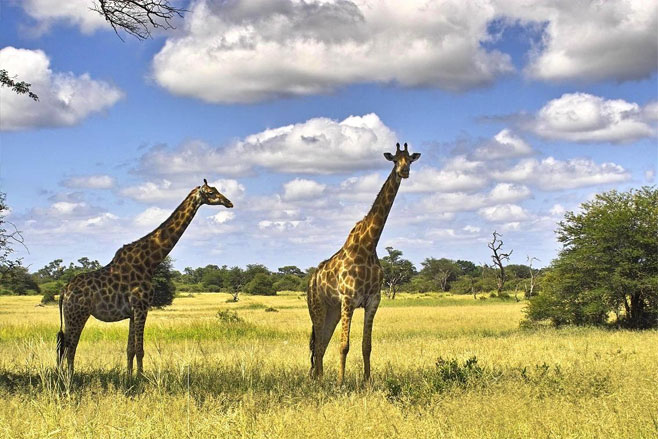 |
| Giraffes, Kruger National Park, South Africa. [photo Arno Meintjes
©] |
Identification
Giraffes are the tallest living animals and are easily
recognized by their distinct elongated body shape, with a very long neck and
legs and a relatively short body. It is thought that the reason for the
evolution of this “tallness” is to provide access to foliage in the tree canopy.
The irregular blotched patterns on a giraffe’s coat offer
some camouflage by imitating the dappling effect of light and shade found in
savannah woodlands. The coat patterns are distinctive for each giraffe, rather
like a human figure print. Bulls are usually darker in colour than cows.
Size
Male: Body Length 3.8 – 4.7 m; height to horn tip
4.7-5.3 m; weight range 800 - 1930 kg.
Female: Height to horn tips 3.9 – 4.5 m; weight range 550 – 1 180 kg.
Dental formula
I C C P P M M =
32 =
32
Distribution and habitat
Occurs in open woodland and wooded grassland south of the
Savanna.
Physiology
Being so tall carries some physiological costs. The
giraffe’s heart is about 2 m above its hooves and 3 m below its brain. The blood
vessels in their long legs are prevented from leaking blood through the
capillary walls by a very tight thick sheath of skin around the slender lower
half of each leg. This has the same effect as the G-suits worn by fighter pilots
that prevent blackouts during acceleration to higher altitude. The giraffe’s
blood pressure measured at the heart is 215mmHg is twice that of a cow, while
the blood pressure in the brain is much lower at 90mmHg, this is much the same
as most large mammals. To prevent blood rushing down the neck and causing the
brain to literally explode when the giraffe lowers its head to drink, there is
an intricate network of fine blood vessels at the base of the brain. This is a
pressure regulating system called the carotid rete. The strange splayed drinking
position of the giraffe also helps to bring chest closer to the ground and
reduce the height difference between the heart and the brain. The giraffe has seven cervical (neck) vertebrae, exactly
the same number of neck bones found in all mammals. In the giraffe these bones
are greatly elongated.
Giraffes are the largest ruminants and like all other animals in this group they
have to chew their food more than once. When the food is regurgitated up the
long esophagus, a tennis-ball shape is clearly visible in the neck.
Food
Giraffes are pure browsers and feed almost exclusively on
trees and shrubs, up to a level of about 5m. When available they select the high
quality plant parts, such us fresh leaves, shoots, flowers, and fruits. Bulls
tend to feed higher than cows and more commonly stretch to feed. The reasons for
this are not clear but it is thought to reduce competition for food within the
herd. The giraffe has a long powerful tongue that is a blue gray in colour. It
is very dextrous and together with the highly mobile muscular lips efficiently
strips leaves from spiney acacia branches.
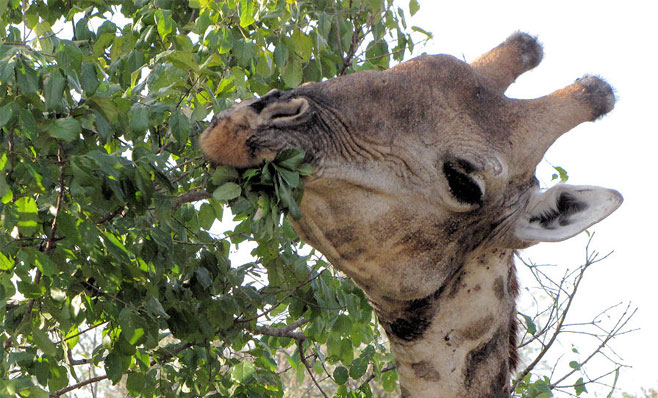 |
|
Giraffe feeding on some leaves, Kruger National
Park, South Africa. [photo
Dave Scott
©] |
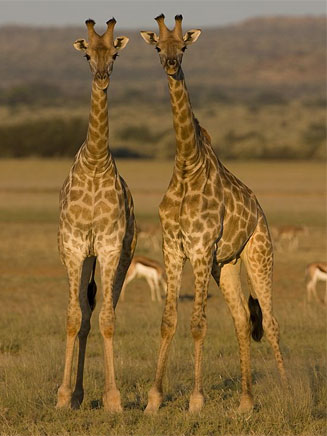 |
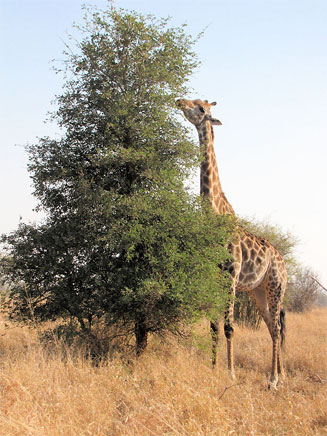 |
|
Giraffes, Rooipoort Nature Reserve, South Africa. [photo Trevor Hardaker ©] |
Giraffe browsing an Acacia tree, Kruger
National Park, South Africa. [photo
Dave Scott
©] |
Reproduction
The social structure is simple with groups of giraffe’s
usually consisting of less than 20 animals. The animals tend to move freely
between herd groups, and the only obvious associations are between cows and
their calves. The dominant bulls monopolize mating and roam widely in search of
cows. After a gestation period of 15 months, giraffe cows give birth standing and the calf has a long drop of 2m to the
ground. For the first few weeks the calf will rest alone in the shadows while
its mother feed nearby. Later it will join “nursery groups” of up to 10 calves
in the company of one or two supervisory adults. 15 months
 |
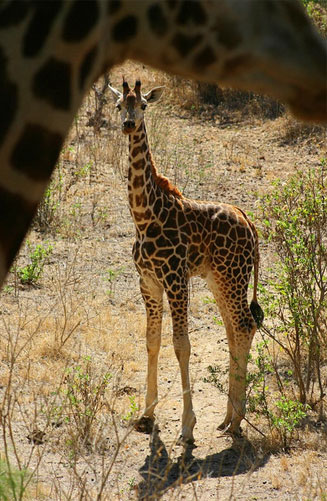 |
|
Giraffes, Ventersburg, Free State, South Africa. [photo Gerhard Theron
©] |
Giraffe calf, Kenya. [photo Crazy Kanga ©] |
Life span
25 years in the wild, 28 years in captivity.
Conservation
Giraffes have lost over 50% of their historical
geographical range; this is as a result of over-hunting and habitat loss,
combined with periodic outbreaks of cattle borne diseases. While not currently
regarded as threatened their conservation status is lower risk and conservation
dependent.
|
